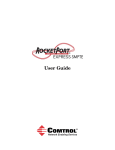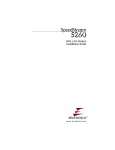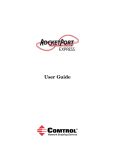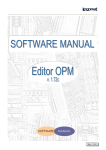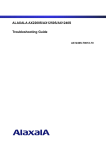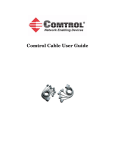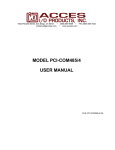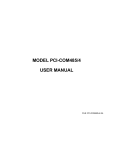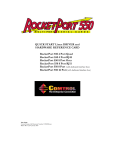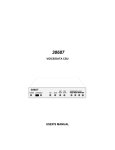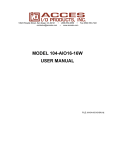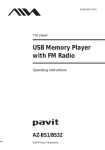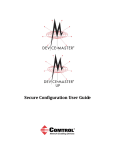Download RocketPort Universal PCI User Guide
Transcript
User Guide Trademark Notices Comtrol and RocketPort are trademarks of Comtrol Corporation. Windows and Microsoft are registered trademarks of Microsoft Corporation. Other product names mentioned herein may be trademarks and/or registered trademarks of their respective owners. Seventh Edition (Rev G), October 13, 2011 Copyright © 2011. Comtrol Corporation. All Rights Reserved. Comtrol Corporation makes no representations or warranties with regard to the contents of this document or to the suitability of the Comtrol product for any particular purpose. Specifications subject to change without notice. Some software or features may not be available at the time of publication. Contact your reseller for current product information. Document Number: 2000284 Rev. G Table of Contents Overview...................................................................................................................................5 Product Overview.......................................................................................................................................... 5 Supported Models.......................................................................................................................................... 5 Before Installing the RocketPort Universal PCI ................................................................................... 6 Locating the Latest Drivers and Documentation .................................................................................. 6 Card and Interface Installation ..........................................................................................7 Installing the Card ........................................................................................................................................ 7 Attaching a Quadcable or Octacable Interface ...................................................................................... 7 Attaching a Panel Interface Box ................................................................................................................ 8 Installing a Rackmount Interface Box ..................................................................................................... 9 Connecting Serial Devices .................................................................................................11 DTE Versus DCE .......................................................................................................................................... 11 DB9 Serial Cables and Loopback Plugs ................................................................................................. 11 DB9 Signals............................................................................................................................................... 12 DB9 Null-Modem Cables.......................................................................................................................... 12 RS-232 Null-Modem Cable ............................................................................................................... 12 RS-422 Null-Modem Cable ................................................................................................................ 13 DB9 Straight-Through Cables ................................................................................................................. 13 DB9 Loopback Plugs................................................................................................................................. 13 RS-232 Female Loopback Plug .......................................................................................................... 13 RS-422 Loopback Plug ....................................................................................................................... 13 DB25 Serial Cables and Loopback Plugs ............................................................................................... 14 DB25 Signals............................................................................................................................................. 14 DB25 Null-Modem Cables........................................................................................................................ 15 DB25 Null-Modem Cables (RS-232) ........................................................................................................ 15 DB25 Null-Modem Cables (RS-422) .................................................................................................. 15 DB25 Straight-Through Cables (RS-232)................................................................................................ 15 DB25 Loopback Plugs............................................................................................................................... 16 RS-232 Female Loopback Plug .......................................................................................................... 16 RS-422 Female Loopback Plug .......................................................................................................... 16 RS-232 Male Loopback Plug .............................................................................................................. 16 RS-422 Male Loopback Plug .............................................................................................................. 16 RJ45 Serial Cables and Loopback Plugs (4J)........................................................................................ 17 RJ45 Pinouts ............................................................................................................................................. 17 RJ45 Null-Modem Cables ........................................................................................................................ 17 RJ45 Straight-Through Cables ............................................................................................................... 18 RJ45 Loopback Plugs................................................................................................................................ 18 RJ11 Serial Cables and Loopback Plugs (8J)........................................................................................ 19 RJ11 Pinouts ............................................................................................................................................. 19 RJ11 Null-Modem Cables......................................................................................................................... 19 RJ11 Null-Modem Cable (RS-232) .................................................................................................... 19 RJ11 Null-Modem Cable (RS-422) .................................................................................................... 19 RJ11 Straight-Through Cable (RS-232) .................................................................................................. 20 RJ11 Loopback Plugs................................................................................................................................ 20 RocketPort Universal PCI User Guide: 2000284 Rev. G Table of Contents - iii Table of Contents Troubleshooting ...................................................................................................................21 Before Calling Technical Support ........................................................................................................... 21 RocketPort Universal PCI Diagnostics .................................................................................................. 21 Bootable CD .............................................................................................................................................. 22 Running the Bootable Diagnostic CD ...................................................................................................... 22 Testing a Port or Ports ....................................................................................................................... 22 Stress Testing the RocketPort Universal PCI .................................................................................. 23 Exiting the Diagnostic ....................................................................................................................... 23 If the Diagnostic Fails ........................................................................................................................ 23 Troubleshooting Windows Systems......................................................................................................... 23 Comtrol Utility.......................................................................................................................................... 24 Using PortMon to Test the Driver Installation ................................................................................ 26 Using Test Terminal to Test a Port ................................................................................................... 29 Troubleshooting Linux Systems .............................................................................................................. 31 lcom(1) ....................................................................................................................................................... 31 File Transfer ............................................................................................................................................. 31 Changing Serial Port Settings (stty) ....................................................................................................... 31 Setting Up Terminals and Modems (mgetty, getty) ............................................................................... 31 Testing with minicom ............................................................................................................................... 31 Technical Support ....................................................................................................................................... 32 iv - Table of Contents RocketPort Universal PCI User Guide: 2000284 Rev. G Overview Product Overview The RocketPort Universal PCI series multiport serial card fits into the PCI slot of a personal computer, and uses a 36 MHz processor that is specifically designed to process asynchronous serial communications. It supports 3.3 and 5.0 volt PCI bus architecture and is compatible with 32- and 64-bit PCI slots. The RocketPort Universal PCI series uses Comtrol Application Specific Integrated Circuit (ASIC) technology to replace most hardware functionality to minimize components, including: • The processor • A serial controller • Bus interface logic and other miscellaneous logic You can install up to four RocketPort Universal PCI cards in one computer, providing a maximum of 128 additional serial ports. The PC must comply with the PCI 2.2 specification or greater. Supported Models The RocketPort Universal PCI family consists of the following models: • 4-Port adapters with the following interface options: - • 8-Port adapters with the following interface options: - • Octacable (fanout cable) with DB9, DB25, or RJ45 connectors RJ11 connectors built into the edge of the card Panel mount RS-232 interface box with DB25F connectors Panel mount RS-232/422 interface box with DB25F connectors Panel mount RS-232/422 Surge interface box with DB25M connectors 16-Port adapter with the following interface options: - • Quadcable (fanout cable) with DB9 or DB25 connectors RJ45 connectors built into the edge of the card Panel mount RS-232 interface box with sixteen DB25F connectors Panel mount RS-232/422 interface box with sixteen DB25F connectors Panel mount RS-232/422 Surge interface box with sixteen DB25M connectors Rack mount RS-232 interface box with sixteen RJ45 connectors Rack mount RS-422 interface box with sixteen RJ45 connectors 32-Port adapter with the following interface options: - Panel mount RS-232 interface box with sixteen DB25F connectors Panel mount RS-232/422 interface box with sixteen DB25F connectors Panel mount RS-232/422 Surge interface box with sixteen DB25M connectors Rack mount RS-232 interface box with sixteen RJ45 connectors RocketPort Universal PCI User Guide: 2000284 Rev. G Overview - 5 Overview - Rack mount RS-232 interface box with thirty-two RJ45 connectors Rack mount RS-422 interface box with sixteen RJ45 connectors Before Installing the RocketPort Universal PCI If you are planning on installing the RocketPort Universal PCI in a Windows system make sure that you have placed the device driver assembly to a location that is available to the host system before installing the card in the host. You can use the Software and Documentation CD to locate the latest device drivers and documentation. Optionally, you can use the links in the following subsection. You may want to record the model and serial number of the RocketPort Universal PCI before installing the card in the event you need to call technical support. Locating the Latest Drivers and Documentation This table contains links the software and installation documentation. Software or Document 6 - Overview Location Device drivers ftp://ftp.comtrol.com/html/RPuPCI_drivers.htm Diagnostic and Utilities ftp://ftp.comtrol.com/html/RPuPCI_diag.htm User Guides ftp://ftp.comtrol.com/html/RPuPCI_docs.htm RocketPort Universal PCI User Guide: 2000284 Rev. G Card and Interface Installation Installing the Card Use the following procedure to install a RocketPort Universal PCI card. 1. If this is a Windows installation, copy the latest driver to your system before installing the RocketPort Universal PCI. See Locating the Latest Drivers and Documentation on Page 6 to locate the latest driver and installation documentation. 2. Turn off the host computer. Note: You may want to write down the model number and serial number of the card before installation. 3. Remove the system cover from your computer. 4. Select a PCI expansion slot. 5. Remove the slot cover or release the clamp. 6. Insert the card into the slot and seat it securely. 7. Reinstall the expansion slot retaining screw or clamp. Do not connect an interface to the card when the host system is powered on, this can cause card failure. Caution 8. Attach the interface or cable to the RocketPort Universal PCI: • If this is a 4J or 8J installation, see Connecting Serial Devices on Page 11 for cabling information after driver installation. • Attaching a Quadcable or Octacable Interface on Page 7 (below) • Attaching a Panel Interface Box on Page 8 • Installing a Rackmount Interface Box on Page 9 Attaching a Quadcable or Octacable Interface Use this procedure to complete the Quadcable or Octacable installation. 1. Make sure that the host system is powered off before connecting the cable. 2. Attach the DB78 end of the Quadcable or Octacable to the card. Caution Make sure that the connectors are properly aligned and forcefully push the connector of the Quadcable or Octacable with a rocking motion into the card connector. Make sure that the connector is seated tightly before tightening the retaining screws on the connector. Octacable DB9 3. Tighten the retaining screws on the connector. 4. Power on the host system. 5. Click Cancel if a Found New Hardware message appears on a Windows operating system. Execute the device driver file to start the driver installation. RocketPort Universal PCI User Guide: 2000284 Rev. G Card and Interface Installation - 7 Card and Interface Installation For other operating system device drivers, see Locating the Latest Drivers and Documentation on Page 6. 6. After installing the driver, you should verify that the ports are functioning properly and then connect your serial devices. You can use the Troubleshooting section on Page 21 for port testing procedures for your operating system. Refer to Connecting Serial Devices on Page 11 for information about connecting serial devices. Attaching a Panel Interface Box Use the following to attach a panel interface box. Do not connect the cable to the RocketPort Universal PCI card or interface box when the computer is powered on. Connecting the cable to the RocketPort Universal PCI card or interface box while the computer is powered on may damage the electronics on the card or interface box. Caution 1. Make sure that the host system is powered off before connecting the cable 2. Attach the male end of the RocketPort Universal PCI cable to the card and the female end to the connector labeled Host on the interface box. Note: The male DB25 port labeled Host is reserved for Comtrol use and no user accessible signals are present at this port. 3. Tighten the retaining screws. Note: If you have a 32-port adapter, the connector labeled J1 corresponds to Ports 0 through 15 and the connector labeled J2 (closest to the bus) corresponds to Ports 16 through 31. 4. If this is an RS-232/422 switchable interface, make sure that you set the ports to the appropriate interface mode. 5. Power on the host system. 6. Click Cancel if a Found New Hardware message appears on a Windows operating system. Execute the device driver file to start the driver installation. For other operating system device drivers, see Locating the Latest Drivers and Documentation on Page 6. 7. After installing the driver, you should verify that the ports are functioning properly and then connect your serial devices. You can use the Troubleshooting section on Page 21 for port testing procedures for your operating system. Refer to Connecting Serial Devices on Page 11 for information about connecting serial devices. 8 - Card and Interface Installation RocketPort Universal PCI User Guide: 2000284 Rev. G Card and Interface Installation Installing a Rackmount Interface Box Rackmount interface boxes are sturdy enough to allow you to stack several units on a shelf, or you can mount it directly into a rack. Do not connect the cable to the RocketPort Universal PCI card or interface box when the computer is powered on. Caution Connecting the cable to the RocketPort Universal PCI card or interface box while the computer is powered on may damage the electronics on the card or interface box. 1. Make sure that the host system is powered off before connecting the cable. 2. Place the Rackmount interface box on a stable surface or attach the brackets to the interface box using the screws supplied with the unit and attach the bracket into your rack. Note: You can mount the Rackmount interface box facing in either direction. 3. Attach the 3-foot cable or the 3-foot and the 10-foot cables together between the interface and the board. Make sure that the connectors are properly aligned. Do NOT use force when connecting the cables to the host adapter card. Caution Note: The cables are interchangeable. You may connect either or both cables depending upon the distance between the card and the rack. The maximum distance permitted between the interface box and card is 15 feet. 4. Optionally, for the RM32-RJ45, attach the two cables to the card and the interface. The connector labeled J1 corresponds to Host A (Ports 0 through 15), and the connector labeled J2 (closest to the bus) corresponds to Host B (Ports 16 through 32). Do not connect 16-port cards located in different machines to the RM32-RJ45. It is possible to damage the interface and card if the interface is connected to two PCs using separate line power sources. Caution 5. Power on the host system. 6. Click Cancel if a Found New Hardware message appears on a Windows operating system. Execute the device driver file to start the driver installation. For other operating system device drivers, see Locating the Latest Drivers and Documentation on Page 6. 7. After installing the driver, you should verify that the ports are functioning properly and then connect your serial devices. The rackmount interface boxes provide LEDs that display the following: • 16-Port RS-422 (with red LEDs that display port activity) • 16-Port RS-232 with integrated status LEDs. The yellow LEDs show receiving activity. The green LEDs show transmitting activity. RocketPort Universal PCI User Guide: 2000284 Rev. G Card and Interface Installation - 9 Card and Interface Installation • 32-Port RS-232 with integrated status LEDs. The yellow LEDs show receiving activity. The green LEDs show transmitting activity. You can use the Troubleshooting section on Page 21 for port testing procedures for your operating system. Refer to Connecting Serial Devices on Page 11 for information about connecting serial devices. 10 - Card and Interface Installation RocketPort Universal PCI User Guide: 2000284 Rev. G Connecting Serial Devices This section provides information about the RocketPort Universal PCI connectors, in the event that you need to build cables or loopback plugs. • DB9 Serial Cables and Loopback Plugs on Page 11 • DB25 Serial Cables and Loopback Plugs on Page 14 • RJ45 Serial Cables and Loopback Plugs (4J) on Page 17 • RJ11 Serial Cables and Loopback Plugs (8J) on Page 19 A loopback plug is a serial port plug with pins wired together that you can use with application (for example, the diagnostic, Test Terminal, or minicom) to test serial ports. See Before Calling Technical Support on Page 21 for information about using the test application shipped with the RocketPort Universal PCI. DTE Versus DCE Most serial devices, except modems, are Data Terminal Equipment (DTE) devices. Modems are Data Communication Equipment (DCE) devices. How you build a cable depends on which device your are connecting to (DTE or DCE). For example, you need a null-modem cable to connect the COM ports (COM1 or COM2) on the computer or the RocketPort Universal PCI ports to printers, terminals, bar code readers or DNC equipment. If you are connecting a DTE device to a DCE device you need a straight-through modem cable. • Straight-through cable (DTE to DCE) - connects TxD to TxD and RxD to RxD. • Null-modem cable (DTE to DTE) - connects TxD to RxD and RxD to TxD. DB9 Serial Cables and Loopback Plugs The following figures and table illustrate the signals present on DB9 connectors if you need to build your own null-modem or straight-through DB9 serial cables. • DB9 Signals on Page 12 • DB9 Null-Modem Cables on Page 12 • DB9 Straight-Through Cables on Page 13 • DB9 Loopback Plugs on Page 13 RocketPort Universal PCI User Guide: 2000284 Rev. G Connecting Serial Devices - 11 Connecting Serial Devices DB9 Signals This subsection provides DB9 signal information. Refer to the manufacturer’s installation documentation if you need help with the connector pinouts or cabling for the serial device. DB9 Male (Quad/Octacable) Pin 1 Pin 5 Pin 6 DB9 Null-Modem Cables Pin 9 Pin 9 Pin 6 Pins RS-232 Signals RS-422 Signals* 1 CD Not Used 2 RxD TxD- 3 TxD RxD+ 4 DTR Not Used 5 Signal GND Not Used 6 DSR Not Used 7 RTS TxD+ 8 CTS RxD- 9 RI** Not Used * RS-422 is only available if you are using an RS-422 interface box or RS-232/422 switchable interface box. ** RI is only supported on Quad/Octacable cards. You need a null-modem cable to connect to DTE devices. For example, you can connect one end of a a null-modem cable to COM2 on one computer and the other end of the null-modem cable to COM2 on another computer. The following image displays the pinouts for an RS-232 null-modem cable. RocketPort RS-232 Null-Modem Cable DB9 Female (Interface Boxes) Pin 1 Pin 5 DB9 Signal Pins TxD 3 RxD 2 RTS 7 CTS 8 DSR 6 DCD 1 DTR 4 GND 5 Customer DTE DB9 DB25 Pins Pins Signal RxD 2 3 TxD 3 2 CTS 8 5 RTS 7 4 4 20 DTR DCD 1 8 DSR 6 6 GND 5 7 Note: You can also attach a null-modem adapter to one end of a straight-through cable to create a null-modem cable. 12 - Connecting Serial Devices RocketPort Universal PCI User Guide: 2000284 Rev. G Connecting Serial Devices The following image displays the pinouts for an RS-422 null-modem cable. RocketPort RS-422 Null-Modem Cable Signal TxD+ TxDRxD+ DB9 Pins 7 2 3 RxD- 8 Customer DTE Signal RxD+ RxDTxD+ TxD- Note: RS-422 pinouts are not standardized. Each serial device manufacturer uses different pinouts. Refer to the serial device User Manual to determine the signals. DB9 StraightThrough Cables Straight-through cables connect modems to other DCE devices. For example, you can connect one end of a straight-through cable to COM2 on one computer and the other end of a straight-through cable to a modem. The following image displays the pinouts for an RS-232 straight-through cable. RocketPort Customer DCE Signal DCD RxD TxD DTR GND DSR RTS CTS RI DB9 Pins 1 2 3 4 5 6 7 8 9 DB9 DB25 Pins Pins 1 8 2 3 3 2 4 20 5 7 6 6 7 4 8 5 22 9 Signal DCD RxD TxD DTR GND DSR RTS CTS RI Note: Ring Indicator (RI) is only supported on Quad/Octacable cards. DB9 Loopback Plugs RocketPort Universal PCI are shipped with a a single loopback plug. You can use loopback plugs with application software (for example, Test Terminal) to test serial ports. Wire the following pins together to build additional plugs or replace a missing loopback plug. RS-232 Female Loopback Plug The Quadcable and Octacable use the RS-232 female loopback plug. To build a loopback plug for the Quadcable and Octacable, wire the following pins together: • Pins 1 to 4 to 6 • Pins 2 to 3 • Pins 7 to 8 to 9 Pin 1 Pin 5 Pin 9 Pin 6 RS-232 (Back View) Note: Ring Indicator (RI) is only supported on Quad/Octacable cards. RS-422 Loopback Plug To build a DB9 loopback plug for RS-422, wire the following pins together: • Pin 2 to 8 • Pin 3 to 7 RocketPort Universal PCI User Guide: 2000284 Rev. G Connecting Serial Devices - 13 Connecting Serial Devices DB25 Serial Cables and Loopback Plugs The following figures and table illustrate the signals present on DB25 connectors if you need to build your own null-modem or straight-through serial cables. Refer to the manufacturer’s installation guide if you need help with connector pinouts or cables for the peripheral device. DB25 Signals • DB25 Signals • DB25 Null-Modem Cables • DB25 Straight-Through Cables (RS-232) • DB25 Loopback Plugs on Page 16 This subsection provides DB25 signal information. Refer to the manufacturer’s installation documentation if you need help with the connector pinouts or cabling for the serial device. Standard interface modules use female DB25 connectors, while the Surge interface boxes, Quadcable, and Octacable fanouts use male connectors. DB25 Male Surge Interface Boxes Quad/Octacable Pin 1 Pin 13 DB25 Female Standard Interface Boxes Pin 13 Pin 1 Pin 25 Pin 14 Pin 14 Pin 25 This table shows connector information for DB25 connectors. Interface Boxes 14 - Connecting Serial Devices Quad/Octacable Pin RS-232 Signal RS-422 Signal* RS-232 Signal 1 Not used Not used Not used 2 TxD Not used TxD 3 RxD Not used RxD 4 RTS Not used RTS 5 CTS Not used CTS 6 DSR Not used DSR 7 Signal ground Signal ground Signal ground 8 DCD Not used DCD 9 to 14 Not used Not used Not used 15 Not used RxD+ Not used 16 Not used Not used Not used 17 Not used RxD- Not used 18 Not used Not used Not used 19 Not used TxD+ Not used 20 DTR Not used DTR 21 Not used Not used Not used 22 Not used Not used RI** 23-24 Not used Not used Not used 25 Not used TxD- Not used * Quad/Octacables do not support RS-422 mode. RS-422 is only available if you purchased an RS-422 interface box or RS-232/422 interface box. ** RI is only supported on Quad/Octacable adapters. RocketPort Universal PCI User Guide: 2000284 Rev. G Connecting Serial Devices DB25 Null-Modem Cables You need a null-modem cable to connect to DTE devices. For example, you can connect one end of a a null-modem cable to COM2 on one computer and the other end of the null-modem cable to COM2 on another computer. DB25 Null-Modem Cables (RS-232) The following image displays the pinouts for an RS-232 nullmodem cable. RocketPort DTE Serial Device DB25 DB9 DB25 Signal Pins Pins Pins Signal Note: You can also attach a null- TxD 2 2 3 RxD modem adapter to one end RxD 3 3 2 TxD of a straight-through cable RTS 5 4 8 CTS to create a null-modem RI* 22 9 22 RI cable. CTS 5 7 RTS 4 20 DSR 6 4 DTR DCD 8 1 8 DCD DTR 20 6 6 DSR GND 7 5 7 GND * Ring Indicator (RI) is only available on Quad/ Octacables. DB25 Null-Modem Cables (RS-422) DB25 StraightThrough Cables (RS232) The following image displays the pinouts for an RS-422 null-modem cable. RocketPort RS-422 pinouts are not standardized. Each serial device manufacturer uses different pinouts. Refer to the serial device User Manual to determine the signals. Signal TxD+ TxDRxD+ Note: You can also attach a null-modem adapter to one end of a straight-through cable to create a null-modem cable. RxD- DB25 Pins 19 25 15 17 DTE Serial Device Signal RxD+ RxDTxD+ TxD- Use the following figure if you need to build an RS-232 straight-through cable. Straight-through cables are used to connect modems and other DTE devices. For example, a straight-through cable can be used to connect COM2 of one PC to a modem. RocketPort DCE Serial Device DB25 DB9 DB25 Pins Pins Signal Signal Pins 8 1 8 DCD DCD 3 2 3 RxD RxD 2 3 2 TxD TxD 20 4 20 DTR DTR 7 5 7 GND GND 6 6 6 DSR DSR 4 7 4 RTS RTS 5 8 5 CTS CTS RI* 22 22 9 RI * Ring Indicator (RI) is only available on Quad/Octacables. RocketPort Universal PCI User Guide: 2000284 Rev. G Connecting Serial Devices - 15 Connecting Serial Devices DB25 Loopback Plugs RS-232 Female Loopback Plug RS-422 Female Loopback Plug RS-232 Male Loopback Plug RS-422 Male Loopback Plug A loopback plug is a DB25 serial port plug with pins wired together. You can use a loopback plug with application software (for example, Test Terminal) to test serial ports. The Surge RS-232/422 switchable interface box, Quadcable, and Octacable use the RS-232 female loopback plug. To build a DB25 loopback plug for a Surge interface box, Quadcable, or Octacable, wire the following pins together: • Pins 2 to 3 • Pins 4 to 5 to 22 • Pins 6 to 8 to 20 Pin 1 Pin 13 Pin 14 Pin 25 RS-232 Only (Back View) To build a DB25 loopback plug (Surge RS-232/422 switchable interface box) for an RS-422 serial connection, wire the following pins together: Pin 1 Pin 13 • Pins 15 to 19 Pin 14 Pin 25 • Pins 17 to 25 RS-422 Only (Back View) The RS-232 and RS-232/422 interface boxes (8-port and 16-port models) use the RS-232 male loopback plug. To build a DB25 loopback plug for an RS-232 serial connection, wire the following pins together: • Pins 2 to 3 • Pins 4 to 5 to 22 • Pins 6 to 8 to 20 Pins 15 to 19 • Pins 17 to 25 16 - Connecting Serial Devices Pin 1 Pin 25 Pin 14 RS-232 Only (Back View) To build a DB25 loopback plug for an RS-422 serial connection, wire the following pins together. • Pin 13 Pin 13 Pin 1 Pin 25 Pin 14 RS-422 Only (Back View) RocketPort Universal PCI User Guide: 2000284 Rev. G Connecting Serial Devices RJ45 Serial Cables and Loopback Plugs (4J) This section describe how to build your own null-modem or straight-through RJ45 serial cables. • RJ45 Pinouts • RJ45 Null-Modem Cables on Page 17 • RJ45 Straight-Through Cables on Page 18 • RJ45 Loopback Plugs on Page 18 There are no standards for the RJ45. Before you build the custom RJ45 serial cable for your terminal equipment or device you should: RJ45 Pinouts • Refer to the manufacturer’s installation guide if you need help with connector pinouts or cables for the peripheral device. • Supported RS-modes are described in the electronic document shipped with your Comtrol device. The following figures provide pinout information for the RJ45 connectors used on the Octacable interface module. Note: Ring indicator is not supported on the RJ45 connector. RJ45 Null-Modem Cables You need a null-modem cable to connect to DTE devices. For example, you can connect one end of a null-modem cable to COM2 on one computer and the other end of the null-modem cable to COM2 on another computer. You can also attach a null-modem adapter to one end of a straight-through cable to create a null-modem cable. RocketPort The following image displays the pinouts for an RS-232 null-modem cable. RJ45 Signal Pins TxD 4 RxD 5 RTS 1 CTS 8 DSR 7 DCD 6 DTR 2 GND 3 DTE Device DB9 DB25 Pins Pins Signal RxD 2 3 TxD 3 2 CTS 8 5 RTS 7 4 DTR 4 20 DCD 1 8 DSR 6 6 GND 5 7 Note: RJ45 pinouts are not standardized. Each peripheral manufacturer uses different pinouts. Refer to the document for the peripheral device to determine the pinouts for the signals above. RocketPort Universal PCI User Guide: 2000284 Rev. G Connecting Serial Devices - 17 Connecting Serial Devices RJ45 StraightThrough Cables Straight-through cables connect modems to other DCE devices. For example, you can connect one end of a straight-through cable to COM2 on one computer and the other end of the straight-through cable to a modem. RocketPort The following image displays the pinouts for an RS-232 straight-through cable. Signal DCD RxD TxD DTR GND DSR RTS CTS RI RJ45 Pins 6 5 4 2 3 7 1 8 N/A Customer DCE DB9 DB25 Pins Pins Signal 8 1 DCD 3 2 RxD 2 3 TxD 20 4 DTR 7 5 GND 6 6 DSR 4 7 RTS 5 8 CTS 22 9 RI Note: If your RJ45 wiring differs from the one shown above, adjust the RJ45 pinouts accordingly. RJ45 Loopback Plugs A loopback plug is an RJ45 serial port plug with pins wired together. You can use loopback plugs with application software (for example, Test Terminal) to test serial ports. To build an RJ45 loopback plug, wire the following pins together: • Pins 4 to 5 • Pins 1 to 8 • Pins 2 to 6 to 7 18 - Connecting Serial Devices RocketPort Universal PCI User Guide: 2000284 Rev. G Connecting Serial Devices RJ11 Serial Cables and Loopback Plugs (8J) This subsection describes RJ11 cables and looback plugs. • RJ11 Pinouts • RJ11 Null-Modem Cables on Page 19 • RJ11 Loopback Plugs on Page 20 The RocketPort Universal PCI has eight standard RJ11 modular connectors, located on the controller board mounting bracket. The ports are numbered 0 through 7, with Port 7 being the connector closest to the bus. There are no standards for the RJ11. Before you build the custom RJ11 serial cable for your terminal equipment or device you should: • Refer to the manufacturer’s installation guide if you need help with connector pinouts or cables for the peripheral device. • Supported RS-modes are described in the electronic document shipped with your Comtrol device. RJ11 Pinouts This topic describes pinouts for the RJ11 interface connector for an RS-232 port. The following figures provide pinout information for the RJ11 jack plug and receptacle. RJ11 Null-Modem Cables You need a null-modem cable to connect to DTE devices. For example, you can connect one end of a a null-modem cable to COM2 on one computer and the other end of the null-modem cable to COM2 on another computer. RJ11 Null-Modem Cable (RS-232) Use the following figure if you need RocketPort to build an RS-232 null-modem RS-232 RJ11 cable. A null-modem cable is required for connecting DTE devices. Signal Pins TxD RxD CTS DTR DCD GND RJ11 Null-Modem Cable (RS-422) DTE Serial Device DB9 DB25 Pins Pins Signal RxD 2 3 TxD 3 2 RTS 7 4 DCD 1 8 DTR 14 20 GND 5 7 3 4 6 1 5 2 Use the following figure if you need to build an RS-422 null-modem cable. A null-modem RocketPort cable is required for connecting DTE devices. RS-422 Note: RS-422 pinouts are not standardized. Each serial manufacturer uses various pinouts. Please refer to the documentation for the serial to determine the pinouts for the signals in the previous picture. RocketPort Universal PCI User Guide: 2000284 Rev. G RJ11 Signal Pins TxD+ 1 TxD3 RxD+ 6 RxD4 DTE Serial Device Signal RxD+ RxDTxD+ TxD- Connecting Serial Devices - 19 Connecting Serial Devices RJ11 StraightThrough Cable (RS232) Use straight-through cables to connect modems and other DTE devices. For example, you can connect one end of a straight-through cable to COM2 on one computer and the other end of the straight-through cable to a modem. RocketPort Signal DCD RxD TxD DTR GND CTS RJ11 Loopback Plugs RJ11 Pins 5 4 3 1 2 6 DCE Serial Device DB9 DB25 Pins Pins Signal 8 1 DCD 3 2 RxD 2 3 TxD 20 4 DTR 7 5 GND 5 8 CTS A loopback plug is an RJ11 serial port plug with pins wired together. You can use it with application software (for example, Test Terminal) to test serial ports. To build an RJ11 loopback plug, wire these pins together: • Pins 3 to 4 • Pins 1 to 5 to 6 20 - Connecting Serial Devices RocketPort Universal PCI User Guide: 2000284 Rev. G Troubleshooting If you are experiencing problems with the RocketPort Universal PCI, review the troubleshooting procedures for your system before calling Technical Support. Before Calling Technical Support Review the following information before calling Technical Support because they will request that you perform many of the procedures or verifications before they will be able to help you diagnose a problem. • Verify the cabling using Connecting Serial Devices on Page 11. Note: Most customer problems reported to Comtrol Technical Support are eventually traced to cabling or network problems. • If you have not done so, run the diagnostics (RocketPort Universal PCI Diagnostics on Page 21). • Verify that you have installed the latest RocketPort Universal PCI device driver, see Locating the Latest Drivers and Documentation on Page 6. If necessary, remove or update the existing driver using the procedures in the RocketPort Universal PCI Device Driver Installation Guide for Windows or README file packaged with the FreeBSD, Linux, QNX, or SCO OpenServer driver. If none of the above work, you can refer to one of these subsections: • Troubleshooting Windows Systems on Page 23 • Troubleshooting Linux Systems on Page 31 RocketPort Universal PCI Diagnostics This subsection describes how to create and run the bootable diagnostic to verify that the RocketPort Universal PCI hardware is functioning properly. The RocketPort Universal PCI is shipped with a bootable diagnostic on the Software and Documentation CD that executes hardware diagnostics. You can use the diagnostic to: • Confirm that the hardware is functioning • Determine resolutions to conflicts during installation • Perform a stress test on all RocketPort Universal PCI ports in the system The diagnostic requires a loopback plug to test a port or ports. A single loopback plug is shipped with the RocketPort Universal PCI. You can build additional loopback plugs or move the loopback plug to the port you want to test. See Connecting Serial Devices on Page 11 if you want to build loopback plugs. RocketPort Universal PCI User Guide: 2000284 Rev. G Troubleshooting - 21 Troubleshooting Bootable CD Use the following procedure to create a bootable Diagnostic CD. 1. Copy the .iso file to a temporary location. The diagnostic .iso file can be copied from the Software and Documentation CD or you can download the latest version (Locating the Latest Drivers and Documentation on Page 6). 2. Burn the image to a CD-ROM. Note: An .iso file cannot be copied onto a CD but must be burned using an application that burns the image to the CD. If you do not have an application available, you can use a freeware application that is on the Comtrol Software and Documentation CD or download it at: ftp:// ftp.comtrol.com/iso/IsoBurner/. 3. To run the diagnostic, you will need at least one loopback plug. A loopback plug was shipped with the RocketPort Universal PCI. To build a loopback plug, see DB9 Loopback Plugs on Page 13. 4. To start the diagnostic, reboot your system with the Diagnostics CD in the drive and follow the instructions in the diagnostic. Running the Bootable Diagnostic CD Use the following procedure to run the diagnostics. Note: If the diagnostic goes into sleep mode while unattended, press the Num Lock key to activate the screen. Use Ctrl/Alt Delete to kill the diagnostic process at any time. 1. Insert the bootable CD that contains the diagnostic and restart your machine. Note: If the Diagnostic CD does not boot the PC, you may need to change your BIOS settings so that the PC can boot from a CD drive. The diagnostic starts automatically and takes a few moments before the first screen appears. Note: If the diagnostics did not detect the RocketPort Universal PCI, the adapter has a hardware failure, contact Technical support (Page 32). 2. Press Any Key at the disclaimer screen to begin the diagnostic. 3. Press Any Key at the Please Note screen about RocketPort ISA. 4. Press Enter to Are there ISA boards installed? in the VERIFY TEST screen. 5. Press Enter to the Is this board configured for RS-422? query. Note: The caution at the bottom of the screen that the RS-232 test will fail when run on an RS-422 port. 6. Press Enter to the Is this board configured for RJ45 cables? qquery. 7. Select from the following options and use the appropriate steps: Testing a Port or Ports • Testing a Port or Ports • Stress Testing the RocketPort Universal PCI 8. Enter 1 to 4 and press Enter to test a port or ports on a specific RocketPort Universal PCI or on multiple adapters. 9. Press Enter to test ALL ports on the RocketPort Universal PCI or enter the port number of a port that you want to test. 10. Follow the instructions on the screen. If you are testing all of the ports and have only one loopback plug, you must move it from port to port during the test. Note: Port 0 in the diagnostic is Port 1 on the Octacable or interfaces. The diagnostic will provide hardware status on the TESTING SERIAL I/O, MODEM CONTROL AND IRQ screen. 22 - Troubleshooting RocketPort Universal PCI User Guide: 2000284 Rev. G Troubleshooting 11. Choose from the following options: Stress Testing the RocketPort Universal PCI • Press Q to quit the diagnostic without reviewing the Test Summary screen. • Press R to return to the board test screen. • Press any key or Enter to review the Test Summary screen, which provides the ability to restart (Y) or quit (N) the diagnostic. Select S and press Enter to access the STRESS TEST screen. Make sure that you have a loopback plug installed on each port on each adapter. The stress test uses a default configuration to simultaneously stream data to all ports of the RocketPort Universal PCI cards in a system until you stop the test. The following options are available: • To stop the test and review the results of the stress test, enter S. • To return to the board test screen, press R. Exiting the Diagnostic To end the diagnostic, you may need to select b to return to a screen that contains a q to quit. Type reboot, select Enter, and remove the CD from the drive when prompted. If the Diagnostic Fails If the diagnostic fails, try the following before contacting Technical Support. 1. Turn off the power and reseat the RocketPort Universal PCI card into the slot. 2. Try running the diagnostics again. If they fail again, you may have a bad port, contact Technical Support on Page 32. Troubleshooting Windows Systems If you are using a RocketPort Universal PCI driver on a Windows system and the diagnostic verified that the card is functional, you can check the following: 1. Verify that the RocketPort Universal PCI has installed by checking the Device Manager to verify that the RocketPort Universal PCI card displays. 2. Verify that you are addressing the port correctly. In many applications, device names above COM9 require the prefix \\.\ in order to be recognized. For example, to reference COM20, use \\.\COM20 as the file or port name.RocketPort Universal PCI. 3. After driver installation, if a port does not open; go to Ports COM & LPT, rightclick on the yellow exclamation mark on the port, and click Update Driver. Use the same procedure used when installing the ports that are detected with plug and play systems. 4. Enable the Verbose Event Log feature on the Options tab of the RocketPort Universal PCI driver and then reboot the server. 5. Install and use one of the tools in the Comtrol Utility package. Use the following subsection, Comtrol Utility, below for installation and adapter testing procedures. RocketPort Universal PCI User Guide: 2000284 Rev. G Troubleshooting - 23 Troubleshooting Comtrol Utility The Comtrol Utility is available on the Software and Documentation CD or you can download (Page 6) the latest version. The file is a self-extracting zip file that automatically starts the installation procedure. It is not necessary to reboot the PC after installation. The Comtrol Utility package includes the following applications that you can access from the Comtrol Program group: • Port Monitor (PMon2) checks for errors, modem control, and status signals. In addition, it provides you with raw byte input, output counts, and confirm that the device driver is functioning. It can determine if the ports are in use by another application. • Test Terminal (WCOM2) can be used to troubleshoot communications on a portby-port basis (Using Test Terminal to Test a Port on Page 29). Test Terminal requires a loopback plug. You can build a loopback plug if you are missing the loopback plug shipped with the adapter (Connecting Serial Devices on Page 11). Use the following procedure to install the Comtrol Utility package. 1. Execute the Comtrol_Utility_Pack age_x.xx.msi file, where x_xx is the Comtrol Utility version number. 2. Click Next. 3. Click Next. 24 - Troubleshooting RocketPort Universal PCI User Guide: 2000284 Rev. G Troubleshooting 4. Click Install. 5. Click Finish. 6. Go to Using PortMon to Test the Driver Installation on Page 26. RocketPort Universal PCI User Guide: 2000284 Rev. G Troubleshooting - 25 Troubleshooting Using PortMon to Test the Driver Installation You can use PortMon to check whether the RocketPort Universal PCI can communicate through the device driver for Windows. If necessary, use Comtrol Utility on Page 24 to install PortMon. 1. From the Start menu, select Programs > Comtrol > Utilities > Port Monitor (PMon2). 2. Click Add Ports using the icon or Tools > Add Ports, click Driver, ROCKETPORT, and click Ok. 26 - Troubleshooting RocketPort Universal PCI User Guide: 2000284 Rev. G Troubleshooting 3. If the RocketPort Universal PCI is communicating with the device driver for Windows, Port Monitor should display CLOSED status. If a port is open for an application, it displays as OPEN, and displays Actual Throughput, TxTotal and RxTotal statistics. Normally, there should be no data errors recorded or they should be very small. To find out what the actual errors are, scroll to the right. You will see three columns: Overrun Errors, Framing Errors, and Parity Errors. If the errors are: • Overrun Errors represent receive buffer overflow errors. If this is the case, you will have to configure either software or hardware handshaking to control the flow of data. The most common errors are Overrun errors. • Framing Errors indicate that there is an synchronization error between the beginning of a data frame and the end of the data frame. A frame usually consists of a start bit, 8 data bits, and a stop bit or two. The framing error occurs if the stop bit is not detected or it occurs in the wrong time frame. Most causes for framing errors are electrical noise on the data lines, or differences in the data clocks of the RocketPort Universal PCI and the connected device. • Parity Errors occur when parity is used and the parity bit is not what is expected. This can also be caused by noise on the data lines. 4. You can view additional statistics to Port Monitor by adding columns. Click Tools and Add Columns. RocketPort Universal PCI User Guide: 2000284 Rev. G Troubleshooting - 27 Troubleshooting 5. Highlight or shift-click to add multiple statistics and click Ok. Note: See the Port Monitor help system if you need an explanation of a column. 6. Scroll to the right to view the new columns. 7. If you want to capture this session, you can save a current session as a report. To do this, select one of the following save options: • File > Save As • File > Save - if the report already exists in an older format • Save Active Session button Reports can be opened, viewed and re-used when needed. To open and view a report: a. Select File > Open or the Open Existing Session Session dialog appears. button. The Open b. Locate the session (table), you want to open and click the Open button. Optionally, if you want to continue monitoring for an existing session, you need to activate the Polling Interval. • Select Tools > Settings to access the PMon2 Settings dialog • Change the Polling Interval field to a value other than zero (0) 8. Leave Port Monitor open so that you can review events when using Test Terminal to test a port or ports. 28 - Troubleshooting RocketPort Universal PCI User Guide: 2000284 Rev. G Troubleshooting Using Test Terminal to Test a Port Test Terminal (WCom2) allows you to open a port, send characters and commands to the port, and toggle the control signals. This application can be used to troubleshoot communications on a port-by-port basis. The Send and Receive Test Data sends data out the transmit line to the loopback plug, which has the transmit and receive pins connected thus sending the data back through the Rx line to Test Terminal, which then displays the received data in the terminal window for that port. This test is only testing the Tx and Rx signal lines and nothing else. A failure in this test will essentially prevent the port from working in any manner. The Loopback Test tests all of the modem control signals such as RTS, DTR, CTS, DSR, DCD, and RI along with the Tx and Rx signals. Note: This test will fail if set to RS-422 mode on the interface box and is expected to fail since RS-422 does not have the modem control signals that are present in RS-232 for which this test is designed. The following procedure shows how to use Test Terminal to send and receive test data to the serial ports and run a loopback test. If necessary, install the Comtrol Utility package using Comtrol Utility on Page 24. 1. Stop all applications that may be accessing the ports such as RRAS or any faxing or production software. See the appropriate help systems or manuals for instructions on stopping these services or applications. If another application is controlling the port, then Test Terminal will be unable to open the port and an error message will be shown. 2. From the Start menu, select Programs > Comtrol > Utilities > Test Terminal (WCom2). 3. Select File > Open Port, the appropriate port (or ports) from the Open Ports drop list and Ok. Note: If you left Port Monitor open from the previous subsection, you should show that the port is open. 4. Install the loopback plug (Connecting Serial Devices on Page 11) onto the port (or ports) that you want to test. 5. Select Port > Send and Receive Test Data. RocketPort Universal PCI User Guide: 2000284 Rev. G Troubleshooting - 29 Troubleshooting You should see the alphabet scrolling across the port. If so, then the port installed properly and is operational. Note: If you left Port Monitor running, it should show data sent and received and show the average data throughput on the port. 6. Select Port > Send and Receive Test Data to stop the scrolling data. 7. Close Test Terminal. If this test successfully completed, then the port is operational as expected. Note: Do NOT forget to restart the communications application. 30 - Troubleshooting RocketPort Universal PCI User Guide: 2000284 Rev. G Troubleshooting Troubleshooting Linux Systems You can use the following subsections to test the serial ports. lcom(1) Comtrol has available lcom(1), which is a multiport serial I/O test program. You can use lcom in test mode to send test data to any serial port. lcom is available on the Software and Documentation CD or you can download the latest version. Note: For assistance using lcom, use the manual page, lcom(1) that accompanies the program. File Transfer You can transfer a file using the following information. The default settings are 9600, 8, n, 1, and no parity. To send a file you can redirect output to a device; for example: cat /etc/inittab > /dev/ttyR0 Sends the contents of the /etc/inittab file to the ttyR0 device at 9600 baud, 8, n, 1, and no parity. Changing Serial Port Settings (stty) Use the following information if you need assistance changing or viewing the baud rate settings. To change the baud rate, use the following example, which changes the baud rate to 19200: stty 19200 </dev/ttyR0 To view the current serial port settings for ttyR0, enter: stty -a </dev/ttyR0 Note: Settings changes via stty are only valid during current log in session. For permanent setting changes, use the /etc/inittab file. Setting Up Terminals and Modems (mgetty, getty) Add the appropriate line or lines to the /etc/inittab file then restart. Terminal Example: T0:23:respawn:/sbin/agetty -L ttyR0 57600 vt100 Modem Example: T1:23:respawn:+/sbin/mgetty -m ‘”” AT&F OK’ -D -x9 -s 115200 ttyR0 Note: If necessary, see the manual pages for more information on mgetty. Testing with minicom You can also use minicom, which shipped with most Linux distributions, to test the serial ports. A Comtrol document is available for using minicom. RocketPort Universal PCI User Guide: 2000284 Rev. G Troubleshooting - 31 Troubleshooting Technical Support Comtrol has a staff of support technicians available to help you. You should review Before Calling Technical Support on Page 21 before calling Technical Support. If you call for Technical Support, please have the following information available: • Model number • Serial number • Interface type • Operating system type, release, and service package, and if Linux, the kernel version • Device driver version • Computer make, model, speed, and single or dual processor • List other devices in the computer and their addresses Contact Method Corporate Headquarters Support http://www.comtrol.com/pub/en/Support Web site http://www.comtrol.com Phone 763.494.4100 Downloads ftp://ftp.comtrol.com/html/default.htm Note: See Locating the Latest Drivers and Documentation on Page 6 for additional links. 32 - Troubleshooting RocketPort Universal PCI User Guide: 2000284 Rev. G

































